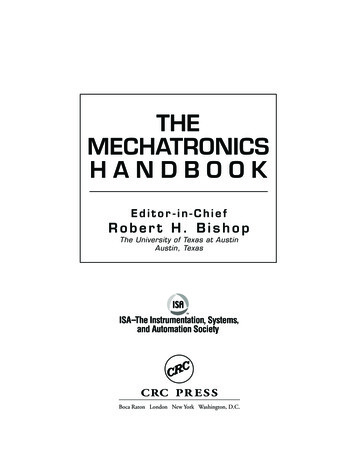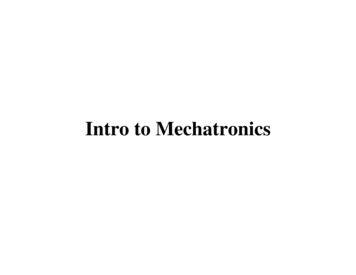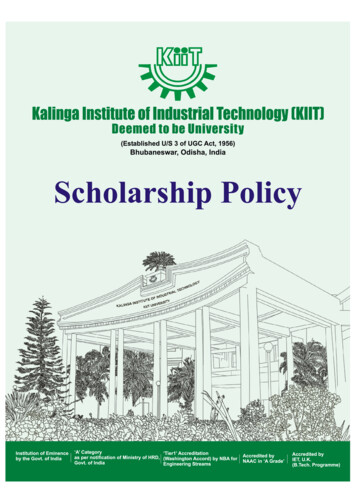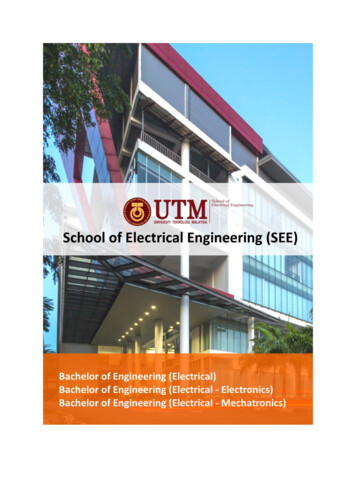
Transcription
THEMECHATRONICSHANDBOOKEditor-in-ChiefRobert H. BishopThe University of Texas at AustinAustin, TexasCRC PR E S SBoca Raton London New York Washington, D.C.
0066 disclaimer Page 1 Friday, January 18, 2002 3:07 PMThis reference text is published in cooperation with ISA Press, the publishing division of ISA–The Instrumentation, Systems,and Automation Society. ISA is an international, nonprofit, technical organization that fosters advancement in the theory,design, manufacture, and use of sensors, instruments, computers, and systems for measurement and control in a wide varietyof applications. For more information, visit www.isa.org or call (919) 549-8411.Library of Congress Cataloging-in-Publication DataCatalog record is available from the Library of CongressThis book contains information obtained from authentic and highly regarded sources. Reprinted material is quoted withpermission, and sources are indicated. A wide variety of references are listed. Reasonable efforts have been made to publishreliable data and information, but the authors and the publisher cannot assume responsibility for the validity of all materialsor for the consequences of their use.Neither this book nor any part may be reproduced or transmitted in any form or by any means, electronic or mechanical,including photocopying, microfilming, and recording, or by any information storage or retrieval system, without priorpermission in writing from the publisher.All rights reserved. Authorization to photocopy items for internal or personal use, or the personal or internal use of specificclients, may be granted by CRC Press LLC, provided that 1.50 per page photocopied is paid directly to Copyright ClearanceCenter, 222 Rosewood Drive, Danvers, MA 01923 USA The fee code for users of the Transactional Reporting Service isISBN 0-8493-0066-5/02/ 0.00 1.50. The fee is subject to change without notice. For organizations that have been granteda photocopy license by the CCC, a separate system of payment has been arranged.The consent of CRC Press LLC does not extend to copying for general distribution, for promotion, for creating new works,or for resale. Specific permission must be obtained in writing from CRC Press LLC for such copying.Direct all inquiries to CRC Press LLC, 2000 N.W. Corporate Blvd., Boca Raton, Florida 33431.Trademark Notice: Product or corporate names may be trademarks or registered trademarks, and are used only foridentification and explanation, without intent to infringe.Visit the CRC Press Web site at www.crcpress.com 2002 by CRC Press LLCNo claim to original U.S. Government worksInternational Standard Book Number 0-8493-0066-5Printed in the United States of America 1 2 3 4 5 6 7 8 9 0Printed on acid-free paper
0066 frontmatter Page i Thursday, January 17, 2002 11:36 AMPrefaceAccording to the original definition of mechatronics proposed by the Yasakawa Electric Company andthe definitions that have appeared since, many of the engineering products designed and manufacturedin the last 25 years integrating mechanical and electrical systems can be classified as mechatronic systems.Yet many of the engineers and researchers responsible for those products were never formally trained inmechatronics per se. The Mechatronics Handbook can serve as a reference resource for those very samedesign engineers to help connect their everyday experience in design with the vibrant field of mechatronics. More generally, this handbook is intended for use in research and development departments inacademia, government, and industry, and as a reference source in university libraries. It can also be usedas a resource for scholars interested in understanding and explaining the engineering design process. Asthe historical divisions between the various branches of engineering and computer science become lessclearly defined, we may well find that the mechatronics specialty provides a roadmap for nontraditionalengineering students studying within the traditional structure of most engineering colleges. It is evidentthat there is an expansion of mechatronics laboratories and classes in the university environment worldwide. This fact is reflected in the list of contributors to this handbook, including an international groupof 88 academicians and engineers representing 13 countries. It is hoped that the Mechatronics Handbookcan serve the world community as the definitive reference source in mechatronics.OrganizationThe Mechatronics Handbook is a collection of 50chapters covering the key elements of mechatronics:a.b.c.d.e.Physical Systems ModelingSensors and ActuatorsSignals and SystemsComputers and Logic SystemsSoftware and Data AcquisitionSection One – Overview of MechatronicsIn the opening section, the general subject ofmechatronics is defined and organized. The chapters are overview in nature and are intended to providean introduction to the key elements of mechatronics. For readers interested in education issues relatedto mechatronics, this first section concludes with a discussion on new directions in the mechatronicsengineering curriculum. The chapters, listed in order of appearance, are:1. What is Mechatronics?2. Mechatronic Design Approach 2002 CRC Press LLC
0066 frontmatter Page ii Thursday, January 17, 2002 11:36 AM3.4.5.6.System Interfacing, Instrumentation and Control SystemsMicroprocessor-Based Controllers and MicroelectronicsAn Introduction to Micro- and NanotechnologyMechatronics: New Directions in Nano-, Micro-, and Mini-Scale Electromechanical SystemsDesign, and Engineering Curriculum DevelopmentSection Two – Physical System ModelingThe underlying mechanical and electrical mathematical models comprising most mechatronic systemsare presented in this section. The discussion is intended to provide a detailed description of the processof physical system modeling, including topics on structures and materials, fluid systems, electrical systems,thermodynamic systems, rotational and translational systems, modeling issues associated with MEMS,and the physical basis of analogies in system models. The chapters, listed in order of appearance, are:7.8.9.10.11.12.13.14.Modeling Electromechanical SystemsStructures and MaterialsModeling of Mechanical Systems for Mechatronics ApplicationsFluid Power SystemsElectrical EngineeringEngineering ThermodynamicsModeling and Simulation for MEMSRotational and Translational Microelectromechanical Systems: MEMS Synthesis, Microfabrication, Analysis, and Optimization15. The Physical Basis of Analogies in Physical System ModelsSection Three – Sensors and ActuatorsThe basics of sensors and actuators are introduced in the third section. This section begins with chapterson the important subject of time and frequency and on the subject of sensor and actuator characteristics.The remainder of the section is subdivided into two categories: sensors and actuators. The chaptersinclude both the fundamental physical relationships and mathematical models associated with the sensorand actuator technologies. The chapters, listed in order of appearance, are:16. Introduction to Sensors and Actuators17. Fundamentals of Time and Frequency18. Sensor and Actuator Characteristics19. Sensors19.1 Linear and Rotational Sensors19.2 Acceleration Sensors19.3 Force Measurement19.4 Torque and Power Measurement19.5 Flow Measurement19.6 Temperature Measurements19.7 Distance Measuring and Proximity Sensors19.8 Light Detection, Image, and Vision Systems19.9 Integrated Micro-sensors 2002 CRC Press LLC
0066 frontmatter Page iii Thursday, January 17, 2002 11:36 AM20. Actuators20.1 Electro-mechanical Actuators20.2 Electrical Machines20.3 Piezoelectric Actuators20.4 Hydraulic and Pneumatic Actuation Systems20.5 MEMS: Microtransducers Analysis, Design and FabricationSection Four – Systems and ControlsAn overview of signals and systems is presented in this fourth section. Since there is a significant bodyof readily-available material to the reader on the general subject of signals and systems, there is not anoverriding need to repeat that material here. Instead, the goal of this section is to present the relevantaspects of signals and systems of special importance to the study of mechatronics. The section beginswith articles on the role of control in mechatronics and on the role of modeling in mechatronic design.These chapters set the stage for the more fundamental discussions on signals and systems comprisingthe bulk of the material in this section. Modern aspects of control design using optimization techniquesfrom H2 theory, adaptive and nonlinear control, neural networks and fuzzy systems are also included asthey play an important role in modern engineering system design. The section concludes with a chapteron design optimization for mechatronic systems. The chapters, listed in order of appearance, are:21. The Role of Controls in Mechatronics22. The Role of Modeling in Mechatronics Design23. Signals and Systems23.1 Continuous- and Discrete-time Signals23.2 Z Transforms and Digital Systems23.3 Continuous- and Discrete-time State-space Models23.4 Transfer Functions and Laplace Transforms24. State Space Analysis and System Properties25. Response of Dynamic Systems26. Root Locus Method27. Frequency Response Methods28. Kalman Filters as Dynamic System State Observers29. Digital Signal Processing for Mechatronic Applications30. Control System Design Via H2 Optimization31. Adaptive and Nonlinear Control Design32. Neural Networks and Fuzzy Systems33. Advanced Control of an Electrohydraulic Axis34. Design Optimization of Mechatronic SystemsSection Five – Computers and Logic SystemsThe development of the computer, and then the microcomputer, embedded computers, and associatedinformation technologies and software advances, has impacted the world in a profound manner. This isespecially true in mechatronics where the integration of computers with electromechanical systems hasled to a new generation of smart products. The future is filled with promise of better and more intelligentproducts resulting from continued improvements in computer technology and software engineering. Thelast two sections of the Mechatronics Handbook are devoted to the topics of computers and software. In 2002 CRC Press LLC
0066 frontmatter Page iv Thursday, January 17, 2002 11:36 AMthis fifth section, the focus is on computer hardware and associated issues of logic, communication,networking, architecture, fault analysis, embedded computers, and programmable logic controllers. Thechapters, listed in order of appearance, are:35.36.37.38.39.40.41.42.43.Introduction to Computers and Logic SystemsLogic Concepts and DesignSystem InterfacesCommunication and Computer NetworksFault Analysis in Mechatronic SystemsLogic System DesignSynchronous and Asynchronous Sequential SystemsArchitectureControl with Embedded Computers and Programmable Logic ControllersSection Six – Software and Data AcquisitionGiven that computers play a central role in modern mechatronics products, it is very important tounderstand how data is acquired and how it makes its way into the computer for processing and logging.The final section of the Mechatronics Handbook is devoted to the issues surrounding computer softwareand data acquisition. The chapters, listed in order of appearance, are:44.45.46.47.48.49.50.Introduction to Data AcquisitionMeasurement Techniques: Sensors and TransducersA/D and D/A ConversionSignal ConditioningComputer-Based Instrumentation SystemsSoftware Design and DevelopmentData Recording and LoggingAcknowledgmentsI wish to express my heartfelt thanks to all the contributing authors. Taking time in otherwise busy andhectic schedules to author the excellent articles appearing in the Mechatronics Handbook is much appreciated. I also wish to thank my Advisory Board for their help in the early stages of planning the topicsin the handbook.This handbook is a result of a collaborative effort expertly managed by CRC Press. My thanks to theeditorial and production staff:Nora Konopka, Acquisitions EditorMichael Buso, Project CoordinatorSusan Fox, Project EditorThanks to my friend and collaborator Professor Richard C. Dorf for his continued support andguidance. And finally, a special thanks to Lynda Bishop for managing the incoming and outgoing draftmanuscripts. Her organizational skills were invaluable to this project.Robert H. BishopEditor-in-Chief 2002 CRC Press LLC
0066 frontmatter Page v Thursday, January 17, 2002 11:36 AMEditor-in-ChiefRobert H. Bishop is a Professor of Aerospace Engineeringand Engineering Mechanics at The University of Texas at Austin and holds the Myron L. Begeman Fellowship in Engineering. He received his B.S. and M.S. degrees from Texas A&MUniversity in Aerospace Engineering, and his Ph.D. from RiceUniversity in Electrical and Computer Engineering. Prior tocoming to The University of Texas at Austin, he was a memberof the technical staff at the MIT Charles Stark Draper Laboratory. Dr. Bishop is a specialist in the area of planetary exploration with an emphasis on spacecraft guidance, navigation, and control. He is currently working withNASA Johnson Space Center and the Jet Propulsion Laboratory on techniques for achieving precisionlanding on Mars. He is an active researcher authoring and co-authoring over 50 journal and conferencepapers. He was twice selected as a Faculty Fellow at the NASA Jet Propulsion Laboratory and a WelliverFaculty Fellow by The Boeing Company. Dr. Bishop co-authored Modern Control Systems with Prof. R.C. Dorf, and he has authored two other books entitled Learning with LabView and Modern Control SystemDesign and Analysis Using Matlab and Simulink. He recently received the John Leland Atwood Awardfrom the American Society of Engineering Educators and the American Institute of Aeronautics andAstronautics that is given periodically to “a leader who has made lasting and significant contributions toaerospace engineering education.” 2002 CRC Press LLC
0066 frontmatter Page vii Friday, January 18, 2002 6:21 PMContributorsMaruthi R. AkellaKevin C. CraigHalit ErenUniversity of Texas at AustinAustin, TexasRennselaer Polytechnic InstituteTroy, New YorkCurtin University of TechnologyBentley, AustraliaSami A. Al-ArianTimothy P. Crain IIH. R. (Bart) EverettUniversity of South FloridaTampa, FloridaNASA Johnson Space CenterHouston, TexasSpace and Naval Warfare SystemsCenterSan Diego, CaliforniaM. AnjanappaJace CurtisUniversity of MarylandBaltimore, MarylandNational Instruments, Inc.Austin, TexasDragos ArotariteiK. DattaAalborg University EsbjergEsbjerg, DenmarkUniversity of MarylandBaltimore, MarylandRamutis BanseviciusRaymond de CallafonKaunas University of TechnologyKaunas, LithuaniaUniversity of CaliforniaLa Jolla, CaliforniaEric J. BarthSantosh DevasiaVanderbilt UniversityNashville, TennesseeUniversity of WashingtonSeattle, WashingtonPeter BreedveldIvan DolezalUniversity of TwenteEnschede, The NetherlandsTechnical University of LiberecLiberec, Czech RepublicTomas BrezinaC. Nelson DornyTechnical University of BrnoBrno, Czech RepublicUniversity of PennsylvaniaPhiladelphia, PennsylvaniaGeorge T.-C. ChiuStephen A. DyerPurdue UniversityWest Lafayette, IndianaKansas State UniversityManhattan, KansasGeorge I. CohnM.A. ElbestawiCalifornia State UniversityFullerton, CaliforniaMcMaster UniversityHamilton, Ontario, CanadaDaniel A. ConnorsEniko T. EnikovUniversity of ColoradoBoulder, ColoradoUniversity of ArizonaTuscon, Arizona 2002 CRC Press LLCJorge Fernando FigueroaNASA Stennis Space CenterNew Orleans, LouisianaC. J. FraserUniversity of Abertay DundeeDundee, ScotlandKris FullerNational Instruments, Inc.Austin, TexasIvan J. GarshelisMagnova, Inc.Pittsfield, MassachusettsCarroll E. GoeringUniversity of IllinoisUrbana, IllinoisMichael GoldfarbVanderbilt UniversityNashville, TennesseeMargaret H. HamiltonHamilton Technologies, Inc.Cambridge, MassachusettsCecil HarrisonUniversity of Southern MississippiHattiesburg, MississippiBonnie S. HeckGeorgia Institute of TechnologyAtlanta, Georgia
0066 frontmatter Page viii Thursday, January 17, 2002 11:36 AMNeville HoganThomas R. KurfessOndrej NovakMassachusetts Institute ofTechnologyCambridge, MassachusettsGeorgia Institute of TechnologyAtlanta, GeorgiaTechnical University of LiberecLiberec, Czech RepublicKam LeangCestmir OndrusekUniversity of WashingtonSeattle, WashingtonTechnical University of BrnoBrno, Czech RepublicChang LiuHitay ÖzbayUniversity of IllinoisUrbana, IllinoisThe Ohio State UniversityColumbus, OhioMichael A. LombardiJoey ParkerUniversity of IllinoisUrbana, IllinoisNational Institute of Standards andTechnologyBoulder, ColoradoUniversity of AlabamaTuscaloosa, AlabamaMohammad IlyasRaul G. LongoriaFlorida Atlantic UniversityBoca Raton, FloridaUniversity of Texas at AustinAustin, TexasFlorin IonescuKevin M. LynchUniversity of Applied SciencesKonstanz, GermanyNorthwestern UniversityEvanston, IllinoisStanley S. IpsonSergey Edward LyshevskiUniversity of BradfordBradford, West Yorkshire, EnglandIndiana University-PurdueUniversity IndianapolisIndianapolis, IndianaRick HomkesPurdue UniversityKokomo, IndianaBouvard HostickaUniversity of VirginiaCharlottesville, VirginiaWen-Mei W. HwuRolf IsermannDarmstadt University of TechnologyDarmstadt, GermanyHugh JackGrand Valley State UniversityGrand Rapids, MichiganJeffrey A. JalkioUniveristy of St. ThomasSt. Paul, MinnesotaRolf JohanssonLund Institute of TechnologyLund, SwedenJ. KatupitiyaThe University of New South WalesSydney, AustraliaCtirad KratochvilTechnical University of BrnoBrno, Czech Republic 2002 CRC Press LLCStefano PastorelliPolitecnico di TorinoTorino, ItalyMichael A. PeshkinNorthwestern UniversityEvanston, IllinoisCarla PurdyUniversity of CincinnatiCincinnati, OhioM. K. RamasubramanianTom MagruderNorth Carolina State UniversityRaleigh, North CarolinaNational Instruments, Inc.Austin, TexasGiorgio RizzoniFrancis C. MoonThe Ohio State UniversityColumbus, OhioCornell UniversityIthaca, New YorkArmando A. RodriguezThomas N. MooreArizona State UniversityTempe, ArizonaQueen’s UniversityKingston, Ontario, CanadaMichael J. MoranMomoh-Jimoh EyiomikaSalamiThe Ohio State UniversityColumbus, OhioInternational Islamic University ofMalaysiaKuala Lumpur, MalaysiaPamela M. NorrisMario E. SalgadoUniversity of VirginiaCharlottesville, VirginiaUniversidad Tecnica Federico SantaMariaValparaiso, ChileLeila NotashQueen’s UniversityKingston, Ontario, CanadaJyh-Jong SheenNational Taiwan Ocean UniversityKeelung, Taiwan
0066 frontmatter Page ix Friday, January 18, 2002 6:21 PMT. SongRichard ThornBogdan M. WilamowskiUniversity of MarylandBaltimore, MarylandUniversity of DerbyDerby, EnglandUniversity of WyomingLaramie, WyomingMassimo SorliRymantas Tadas TolockaJuan I. YuzPolitecnico di TorinoTorino, ItalyKaunas University of TechnologyKaunas, LithuaniaUniversidad Tecnica Federico SantaMariaVina del Mar, ChileAndrew SterianM. J. TordonGrand Valley State UniversityGrand Rapids, MichiganThe University of New South WalesSydney, AustraliaAlvin StraussMike TylerVanderbilt UniversityNashville, TennesseeNational Instruments, Inc.Austin, TexasFred StolfiCrina VladRennselaer Polytechnic InstituteTroy, New YorkPolitehnica University of BucharestBucharest, Romania 2002 CRC Press LLCQin ZhangUniversity of IllinoisUrbana, IllinoisQingze ZouUniversity of WashingtonSeattle, WashingtonJob van AmerongenUniversity of TwenteEnschede, The Netherlands
0066 Frame FM Page v Wednesday, January 9, 2002 11:38 AMContentsSECTION IOverview of Mechatronics1What is Mechatronics? Robert H. Bishopand M. K. Ramasubramanian2Mechatronic Design Approach3System Interfacing, Instrumentation, and Control SystemsRick Homkes4Microprocessor-Based Controllers and MicroelectronicsOndrej Novak and Ivan Dolezal5An Introduction to Micro- and NanotechnologyAlvin Strauss and Eric J. Barth6Mechatronics: New Directions in Nano-, Micro-, and Mini-ScaleElectromechanical Systems Design, and Engineering CurriculumDevelopment Sergey Edward LyshevskiSECTION IIRolf IsermannMichael Goldfarb,Physical System Modeling7Modeling Electromechanical Systems8Structures and Materials9Modeling of Mechanical Systems for Mechatronics ApplicationsRaul G. Longoria 2002 CRC Press LLCFrancis C. MoonEniko T. Enikov
0066 Frame FM Page vi Wednesday, January 9, 2002 11:38 AM10Fluid Power Systems11Electrical Engineering12Engineering Thermodynamics13Modeling and Simulation for MEMS14Rotational and Translational Microelectromechanical Systems: MEMSSynthesis, Microfabrication, Analysis, and OptimizationSergey Edward Lyshevski15The Physical Basis of Analogies in Physical System ModelsNeville Hogan and Peter C. BreedveldSECTION IIIQin Zhang and Carroll E. GoeringGiorgio RizzoniMichael J. MoranCarla PurdySensors and Actuators16Introduction to Sensors and Actuatorsand T. SongM. Anjanappa, K. Datta17Fundamentals of Time and FrequencyMichael A. Lombardi18Sensor and Actuator .719.819.920Joey ParkerLinear and Rotational Sensors Kevin Lynch and Michael PeshkinAcceleration Sensors Halit ErenForce Measurement M. A. ElbestawiTorque and Power Measurement Ivan GarshelisFlow Measurement Richard ThornTemperature Measurements Pamela Norris and Bouvard HostickaDistance Measuring and Proximity Sensors J. Fernando FigueroaLight Detection, Image, and Vision Systems Stanley IpsonIntegrated Microsensors Chang LiuActuators20.1 Electromechanical Actuators George T.-C. Chiu20.2 Electrical Machines Charles Fraser20.3 Piezoelectric Actuators Habil Ramutis Bansevicius and Rymanta Tadas Tolocka 2002 CRC Press LLC
0066 Frame FM Page vii Wednesday, January 9, 2002 11:38 AM20.4 Hydraulic and Pneumatic Actuation Systems Massimo Sorli and Stefano Pastorelli20.5 MEMS: Microtransducers Analysis, Design, and Fabrication Sergey LyshevskiSECTION IVSystems and Controls21The Role of Controls in Mechatronics22The Role of Modeling in Mechatronics Design23Signals and SystemsJob van AmerongenJeffrey A. Jalkio23.1 Continuous- and Discrete-Time Signals Momoh Jimoh Salami23.2 z Transform and Digital Systems Rolf Johansson23.3 Continuous- and Discrete-Time State-Space ModelsKam Leang, Qingze Zou, and Santosh Devasia23.4 Transfer Functions and Laplace Transforms C. Nelson Dorny24State Space Analysis and System Propertiesand Juan I. Yuz25Response of Dynamic Systems26The Root Locus Method27Frequency Response Methods28Kalman Filters as Dynamic System State ObserversTimothy P. Crain II29Digital Signal Processing for Mechatronic ApplicationsS. Heck and Thomas R. Kurfess30Control System Design Via H 2 OptimizationArmando A. Rodriguez31Adaptive and Nonlinear Control Design32Neural Networks and Fuzzy Systems 2002 CRC Press LLCMario E. SalgadoRaymond de CallafonHitay ÖzbayJyh-Jong SheenBonnieMaruthi R. AkellaBogdan M. Wilamowski
0066 Frame FM Page viii Wednesday, January 9, 2002 11:38 AM33Advanced Control of an Electrohydraulic AxisCrina Vlad and Dragos ArotariteiFlorin Ionescu,34Design Optimization of Mechatronic SystemsKratochvil, and Cestmir OndrusekTomas Brezina, CtiradSECTION V Computers and Logic Systems35Introduction to Computers and Logic Systemsand Fred Stolfi36Digital Logic Concepts and Combinational Logic DesignGeorge I. Cohn37System Interfaces38Communications and Computer Networks39Fault Analysis in Mechatronic SystemsN. Moore40Logic System Design41Synchronous and Asynchronous Sequential SystemsSami A. Al-Arian42Architecture43Control with Embedded Computers and Programmable LogicControllers Hugh Jack and Andrew SterianSECTION VIKevin CraigM.J. Tordon and J. KatupitiyaMohammad IlyasLeila Notash and ThomasM. K. RamasubramanianDaniel A. Connors and Wen-mei W. HwuSoftware and Data Acquisition44Introduction to Data Acquistition45Measurement Techniques: Sensors and TransducersCecil Harrison 2002 CRC Press LLCJace Curtis
0066 Frame FM Page ix Wednesday, January 9, 2002 11:38 AM46A/D and D/A Conversion47Signal Conditioning48Computer-Based Instr umentation Systems49Software Design and Development50Data Recording and Logging 2002 CRC Press LLCMike TylerStephen A. DyerKris FullerMargaret H. HamiltonTom Magruder
Mechatronics Handbook is much appre-ciated. I also wish to thank my Advisory Board for their help in the early stages of planning the topics in the handbook. This handbook is a result of a collaborative effort expertly managed by CRC Press. My thanks to the editorial and production staff: No










